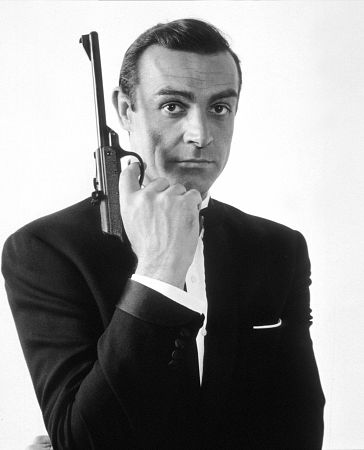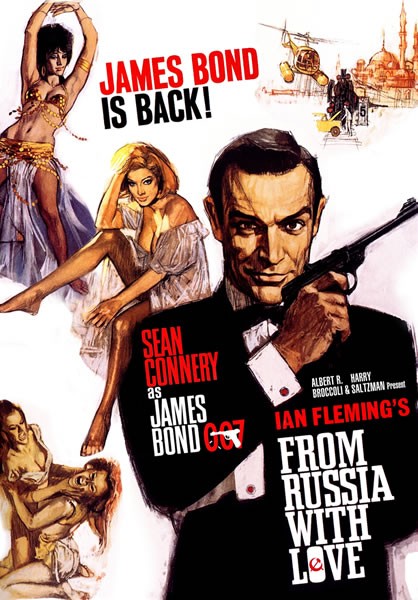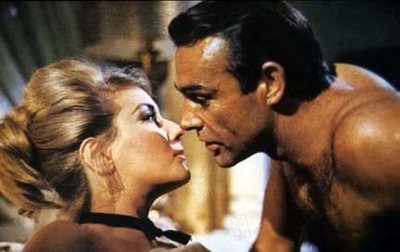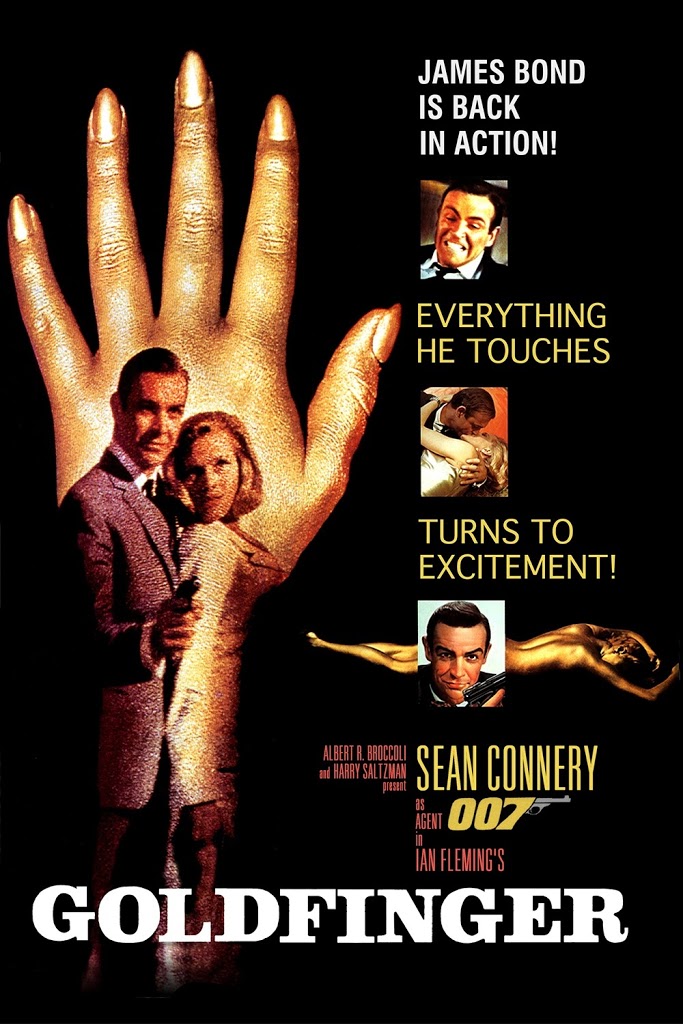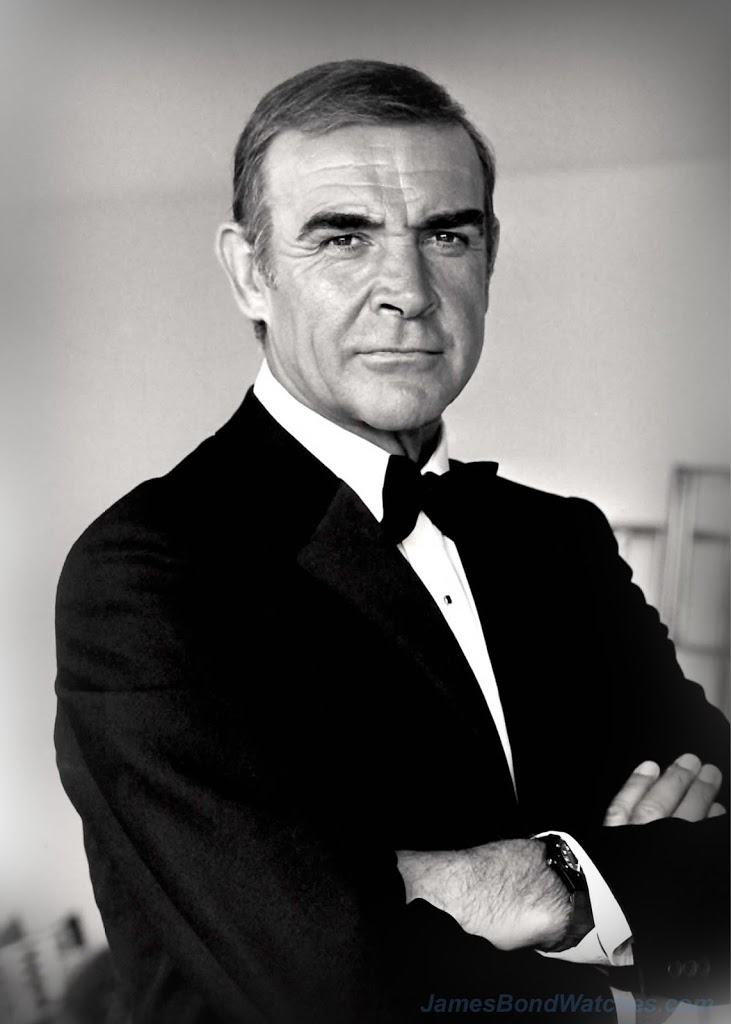“Bond. James Bond.”
And so goes the classic line. Sean Connery was the first actor to play Bond in the long-running film series, and, for many, he’s never been bettered.
I feel I should offer a caveat: I’ve been watching James Bond 007 since I was a kid. It’s probably my favourite movie franchise. For me it’s the cinematic equivalent of comfort food. Like a hamburger, there’s nary a bad one, but they can vary from a standard Big Mac to a Gourmet, caramelized onion, bacon and cheese masterpiece.
What I’m saying that even when they’re not great, they’re still satisfying in a very particular, familiar way. The combination of action, style, repeated plot elements and a sly sense of humour is what makes them work, and allows me to forgive a certain amount of dubious racial and sexual politics, colonial nostalgia, and, depending on the era, silly stuff.
So, Connery as Bond. I’ll go in descending order from my favourite on down.
From Russia With Love (1963) | Directed by Terence Young | Written by Richard Maibaum and adapted from the Fleming novel by Johanna Harwood | 115 min
This picture, the second of the franchise, establishes the template for all the Bond movies to come.
Bond’s mission is to stop SPECTRE (SPecial Executive for Counter-intellegence, Terrorism, Revenge and Extortion, one of movies’ greatest acronyms). SPECTRE’s beef with Bond is already established: he killed their man, Dr. No, in the last film. They’re interested in a cryptography device from the Soviets, called the Lektor, with which they plan to heat up the cold war.
As usual, the plot is a convoluted thing, spy vs. spy. The entertainment is in the action scenes, the exotic locales (Venice and Istanbul) and the characters: SPECTRE consistent villainous presence through the Connery era is personified here by Rosa Klebb (Lotte Lenya) and platinum blonde assassin Grant (Robert Shaw). The “Bond Girl” (as the female lead in these movies has become known) is Tatiana Romanova (Daniela Bianchi, all her lines dubbed), a Russian embassy clerk who wants to defect with the Lektor.
From Russia With Love is where we get to meet series regulars, such as engineering expert Q (Desmond Llewelyn), here credited as Boothroyd, who provides Bond with spy-tech gadgets and, in future movies, treats Bond as a petulant teen who doesn’t respect his lethal tools. There’s also M (Bernard Lee), Bond’s commander, as well as Miss Moneypenny (Lois Maxwell), M’s secretary with whom Bond sustains a long, unconsummated flirtation.
From Russia With Love is also where we get the first pre-credits action sequence followed immediately by the eye-catching opening titles (here designed by Robert Brownjohn, though most of the designs for the first 25 or so years of the series were done by the great Maurice Binder, and here’s a great piece on him from Salon). We also get the John Barry music, with the unmistakable, slightly sinister Monty Norman theme. So much to enjoy; From Russia With Love is where they first got it all right.
And I can’t say enough about Sean Connery. He played a character who was ruthless enough to kill in cold blood and then make a joke about it, providing just the right blend of physicality and wit. And that Connery escaped in the years following from being typecast as Bond is a credit to his versatility as an actor.
You Only Live Twice (1967) | Directed by Lewis Gilbert | Written by Harold Jack Bloom and Roald Dahl | 117 min
This would probably feature further down on most people’s list of the best Bonds, but for me the sheer scale of this entry makes it a favourite. It also was one of the first I saw as a child. There was something so perfectly slick about this Bond, where all the pieces move effortlessly.
SPECTRE is at it again, and this time we actually get a good look at baldy villain Blofeld — the guy Mike Myers spoofed in Austin Powers as Dr Evil — here played by super creepy horror-movie veteran Donald Pleasence.
The organization once again attempts to set the superpowers at each others throats by absconding with rockets in earth orbit. Only the clever Brits figure it has something to do with Japan — and are unable to convince the US or Russians — and so send Bond to investigate before nuclear war breaks out. This is after his death is convincingly faked in the opening credits.
Gadgets from Q include an awesome gyrocopter, and, best of all, the film has ninjas! You Only Live Twice has one of the series’ best theme songs, performed by Nancy Sinatra and subsequently covered by Coldplay and Bjork. And the volcano set, designed by Ken Adam, is one of the franchise’s all-time greatest.
The film’s key debit is that it’s probably the most sexist and culturally insensitive of all the movies (and that’s saying something).
Goldfinger (1964) | Directed by Guy Hamilton | Written by Richard Maibaum and Paul Dehn | 110 min
This is likely the Bond that, if asked, most people will say is the best. How come it shows up after two others in my list from the Connery era? I like to be different.
There is plenty to love here, starting with Gert Frobe as the titular villain, whose dastardly plan is to do something bad with the world’s biggest stash of gold. And he gets the greatest line from a villain in a Bond movie, in response to Bond’s question:
“Do you expect me to talk?”
Goldfinger: “No, Mr Bond, I expect you to die!”
Pussy Galore (Honor Blackman) is the movie’s ridiculously named “Bond Girl,” implicitly lesbian but still unable to resist Bond’s charms, especially when he basically forces himself on her. (Is it any wonder dudes love 007 but women are often harder to convince?) Also, Goldfinger establishes the iconic, burly henchman to the mythos, here named Oddjob (Harold Sakata).
And I’m always happy to see Felix Leiter make an appearance. He’s the CIA agent and sometime friend of James Bond, portrayed by many different actors through the series. (Here it’s Cec Linder.)
My favourite part of Goldfinger is probably the Aston Martin DB5. The British luxury vehicle (here weapon-laden and including ejector seat) is now and forever associated with Bond. I was OK with the fact they moved onto another brand of iconic British sportscar, Lotus Elite, in the mid-70s, though I never understood why Pierce Brosnan’s Bond drove a BMW in Goldeneye. Shouldn’t Bond always be behind the wheel of a British machine?
But I digress.
Diamonds Are Forever (1971) Directed by Guy Hamilton | Written by Richard Maibaum and Tom Mankiewicz | 120 min
This movie brought Connery back to Bond, having been replaced for a single movie by Australian model-turned-actor George Lazenby in On Her Majesty’s Secret Service. Connery was convinced to return by a big paycheque for this, his final time in the tux on an EON picture. There’s a weird post-60s hangover quality to this film, but that’s also what makes it kind of fun. The Las Vegas locations imbue it with a trashiness that definitely speaks of a colder, ’70s cynicism.
SPECTRE’s back, this time Ernst Stavro Blofeld (here played by Charles Gray, complete with hair… these discontinuities and recastings never seemed to matter in Bond) has found a way to clone and duplicate himself. Bond fixes his little red wagon.
The diamonds in the title are being smuggled into the United States, but why? Turns out they’re essential to the operating of laser defence satellites that Blofeld (What? Not dead?!) and his cronies intend to use to threaten the world’s nuclear weapon stockpiles. I think. As I mention above, the twists of many of these films seem pretty arbitrary, in place to provide villains to thwart and women to kiss.
Giving Diamonds Are Forever a unique sparkle are Mr Wint (Bruce Glover, Crispin Glover’s father who also was in Chinatown) and Mr Kidd (Putter Smith), two gay killers. Diamond smuggler Tiffany Case is played by Jill St. John, who may be the most frustrating “Bond Girl” for the well-meaning-but- utterly-ham-handed “help” she provides. While I accept that this series has not often portrayed female characters particularly well, when the machine-gun recoil pushes Tiffany off the oil platform in the final action scene, that just may be a nadir of the franchise’s 50 years.
Still, lots of incidental pleasures to enjoy in this one, the stunt with the muscle car driving on two wheels through a Las Vegas alley being one of them.
Dr. No (1962) | Directed by Terence Young | Written by Richard Maibaum, Johanna Harwood, Berkely Mather, Young (uncredited) and Wolf Mankowitz (uncredited) | 110 min
This is where it all began, and as such it’s very much worth a look — while recognizing that as a more standard spy thriller it’s missing some of the hallmarks of the series.
The pacing of the film is pretty slack, lots of interstitial scenes of Bond driving or walking into buildings, none of which does much to build any kind of suspense. But the puzzle- and set-pieces are arranged in the right order: diabolical evil in SPECTRE, led by Dr No (Joseph Wiseman, who may be in yellow-face, Dr No’s origins are unclear), a beautiful, haughty woman (Ursula Andress as Honey Ryder, whose accent was so thick they dubbed her lines) and an exotic locale (Jamaica) where the baddies are doing their thing.
More of Bond’s humour, cars and gadgets would come in later movies, but the action blueprint is strong.
Never Say Never Again (1983) | Directed Irvin Kershner | written by Jack Whittingham, Kevin McClory, Lorenzo Semple Jr, Ian La Frenais (uncredited) and Dick Clement (uncredited) | 134 min
Connery was convinced to come back to Bond one more time in the early ’80s — when his career wasn’t going all that well as a leading man — but by filmmakers unconnected to EON, the people who make the main 007 franchise. The film is basically a remake of Thunderball, or another adaptation of the Ian Fleming novel, with added frisson of young female lead (Kim Basinger) and the villain ably played by Klaus Maria Brandauer. They don’t shy away from the fact that Connery is in his 50s with a clever pre-credit sequence suggesting he’s (just barely) lost a step, but despite the lack of the distinctive musical theme and the absence of some familiar actors, it’s a reasonable facsimile of the EON Bonds, at least as good as Thunderball and the EON Bond film that came out the same year, Octopussy.
It also costars the amazing Max von Sydow as Blofeld and gives Rowan Atkinson his first gig as a fumbling spy (way before Johnny English) as a guy named Nigel Small-Fawcett. (Think about it.)
(Well, maybe it isn’t quite as good as those other movies, but you can’t deny the thrill in seeing Connery take on the role one more time. It’s like he was born in that tuxedo.)
Thunderball (1965) | Directed by Terence Young | Written by Richard Maibaum, John Hopkins, Jack Whittingham and Kevin McClory | 130 min
This entry into the series, only the fourth, feels to me the most pointlessly bloated of the Connery era. it also feels a bit repetitive, with Bond back in the Caribbean as he was in Dr. No, this time in the Bahamas. Of course, he’s chasing SPECTRE again, the terrorists having stolen a couple of atomic bombs. There’s this first-act silliness where he’s sent to a spa to “improve his health,” but in a happy coincidence, while he’s there he notices criminals getting their features altered through plastic surgery. This, of course, has everything to do with SPECTRE and their evil plans. There’s some fun underwater action late in the running, and a good time with a jetpack early on, but at over two hours Thunderball can drag a little.
I’ve also written up my thoughts on On Her Majesty’s Secret Service, the Roger Moore era, the Timothy Dalton era, the Pierce Brosnan era, and on Daniel Craig.





